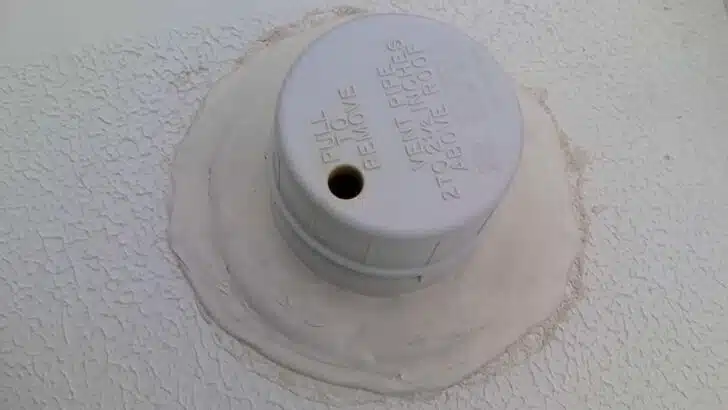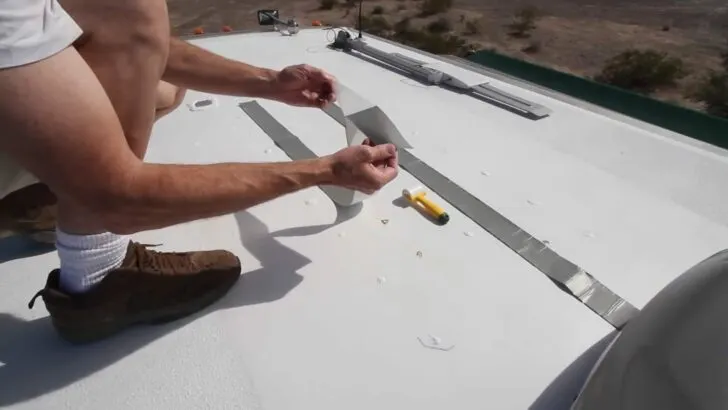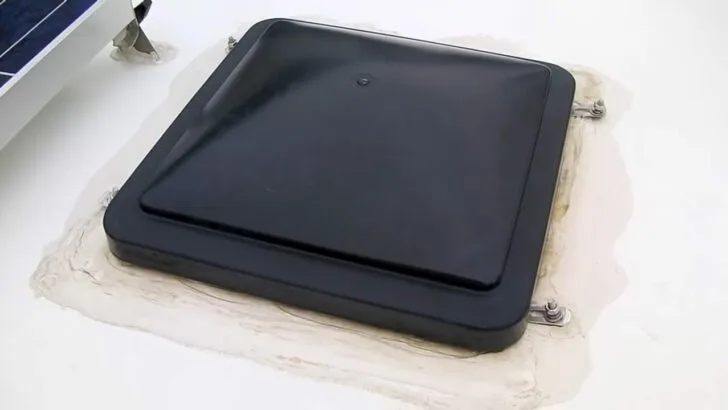RV caulk, or sealant, may be something you don’t think about very much. But it plays an important role in the life of every RVer. Caulk is an essential part of RV living.
Leaks are the bane of an RVer’s existence, but the good news is that leaks can be stopped and more importantly, prevented!
Today we’ve got some RV caulk talk for you, so let’s get rolling!
Types of RV Caulk and Sealant
The first thing an RVer needs to know about caulks and sealants is that there are considerable differences between one type and another. When you head down the caulk and sealant aisle of a hardware store, you’ll find a wide array of options. Choosing the right RV caulk for your particular situation is essential. Let’s take a look at the options so that you can determine which is best for your application.
Self-Leveling Sealant
When applying this type of caulk, it stays soft long enough to allow gravity to level it into a nice smooth surface. As a result, it’s only for use on horizontal surfaces, like your roof, as it will run or sag on vertical surfaces. It’s a polyurethane composite, and when used, it expands (self-levels) into the joints and cracks to seal them. Once dry, it creates a seal resistant to deterioration from water, stress, and movement, since it stays pliable.

Self-leveling sealant is best for use with horizontal applications such as around a vent pipe on the roof.
Non-Self-Leveling Sealant
Like self-leveling sealant, this type of RV caulk seals joints and cracks to resist water and stress. The main difference is that you need to manually spread non-self-leveling sealant; it doesn’t self-level or spread on its own. This type of bond is best for sealing vertical areas, as it won’t run.
Butyl Tape
Butyl tape (sometimes called “putty tape”) is a versatile sealant in tape form. It’s pliable and comes on a roll, like other types of tape, making it easy to apply. It can be used on most surfaces, and it doesn’t make a mess like other sealants can. It’s one of the easiest ways to seal between items, such as when installing a window awning, or replacing a roof vent. It comes in a peel-and-stick roll that you can use as needed with minimal cleanup. It can be used on its own, to seal between two surfaces… but we often use it in conjunction with another sealant, like Dicor Self-Leveling applied around the edges.
- TAPE USE: Ideal for sealing uniquely shaped joints; Installs quickly, without gaps; Because the sealant is on a continuous roll, it's easy to install...
- EASY APPLICATION: Sticks and conforms to any smooth or irregular surface, including S-locks; Apply along unusual patterns
Eternabond
Eternabond also comes in a peel-and-stick roll. Made from a combination of resins and rubbers with a primer added, this sealant works wonders to seal important areas like rooftops. Its bond may not be truly “eternal”… but it’s close! So don’t use Eternabond for anything temporary!

Eternabond tape uses resins and rubber to form a seal that is extremely reliable and durable.
How to Know What Type of RV Caulk to Use for Different Jobs
When considering the type of RV caulk you need for a particular application, the elasticity of the products is an important factor. That’s because RVs move and flex as they travel down the road. More rigid caulks are more prone to cracking or shaking loose during vibration. While “caulk” and “sealant” generally refer to the same family of products, sealants tend to be more flexible, making them great for use on RVs.

Regular maintenance of the self-leveling sealant around rooftop items like your fan keeps these areas leak-free for the life of the RV.
You’ll use each bonding product for specific fixes. Self-leveling sealants are handy when it comes time to repair a roof or horizontal surface. Non-self-leveling sealants are best for vertical surfaces, giving you control over where to place the sealant for maximum effect.
Eternabond tape is a bit pricier, but it can be easier and more efficient to use. It comes in rolls similar to any heavy-duty tape (in different widths) and is strong and flexible. It’s virtually mess-free and works exceptionally well. Many people have solved their leak issues with a simple application of Eternabond.
Keep in mind that adhesive tapes like Eternabond are more difficult to remove. So, if you know you may need to replace the application later, consider using a sealant instead. An example would be sealing around vents or doors.
Additionally, since tapes are more expensive than sealants, a large area in need of repair can get expensive quickly. Most RV owners find that tapes are much easier and faster to apply, so consider your cost versus your time when choosing the best product for you.
Popular Brands of RV Caulk and Sealant
While brand names aren’t everything when choosing the right product, sometimes it’s nice to stick with a reputable brand. Some of our favorite caulk and sealant brands include the following:
Dicor
Dicor offers a variety of self-leveling and non-self-leveling sealants. You can use both quite effectively when you need RV sealant repairs.
You can use Dicor’s self-leveling and non-leveling sealants to create secondary seals around roof edges or vents. They work well with most types of materials such as aluminum, fiberglass, and more. They won’t stain or discolor on application, nor will they fade or deteriorate due to sun and weather. They also come in six different shades to match your color needs.
You’ll find many quality RV caulking and sealants at Dicor, including butyl foam core rolls, other adhesives, and roof coating systems.
- RV ROOFING USE: Lap sealant is sun-ray stabilized to avoid spoiling and discoloration; Plus, it will not stain or discolor any roofing material to...
- COLOR: White hue for stylish and beautiful RV roof
Eternabond
Eternabond is one of the only RV caulking types of sealant that’s made in a tape form and will stop almost any leak or prevent one. A wide variety of people use and love Eternabond. It’s trusted for its ease of use and quality.
Eternabond provides a virtually permanent bond to almost any surface and works well for most non-pressurized leaks. RVers frequently use it on their roofs to prevent leaks because it’s easy to use with minimal mess. It also comes in several colors (white, black, and gray) and different widths (from 2 to 10 inches) so you can choose the right one for the job.
- MULTI-USE: Perfect for use on metal buildings, trailer/RV roofs and sides, drain pans, drain pipes, boats, canoes. bonds to a wide range of surfaces...
- NO ADDITIONAL SEALING REQUIRED: Aluminum backing, combined with a layer of advanced MicroSealant, creates a waterproof, moisture, and air tight...
- Perfect for reseaming all roofs, regardless of the material
- Proven to be UV stable
SikaFlex
Sikaflex polyurethane sealants are some of the best for heavy-duty projects. Their products stay where they are and resist dirt and grime. You can paint the dried sealant any color and immerse it in water.
While SikaFlex products are mostly for sealing concrete expansion joints, they work well for other sealant needs. And they won’t leave you wondering if you did the job right. The quality speaks for itself.
- Sika flex is the most well known brand of one component polyurethane sealant/adhesive in the world
- This fast curing product provides permanent elastic adhesion to a number of surfaces with excellent cut and tear resistance
GeoCel
GeoCel is a leader when it comes to roofing sealants. But they also specialize in other sealants and adhesives for RV caulking needs and building repair jobs.
Their Pro Flex line of sealants will last and withstand almost anything you can throw at them. Pro Flex will seal any leaks, cracks, and crevices you have. It comes in either clear or white, so you can choose the one that works best for your application.
- Crack resistant
- Exceptional flexibility
- Flash Point: 93.0 Degrees_Celsius
- Excellent Adhesion To Many Surfaces, Even When Damp
Why You Shouldn’t Use Plain Silicone to Seal Your RV
RVs move, shift, and vibrate, and silicone dries down to a fairly stiff consistency that isn’t pliable enough for most RV applications. It’s generally strong enough to avoid cracking, but movement and vibration can cause it to separate from the RV’s surface.
Since the silicone itself isn’t likely to crack, that surface separation can go undetected until a leak occurs. Because of this, silicone sealant generally isn’t the right choice for most RV applications. Just about the only place we use silicone sealant in our RV is indoors in the shower, just like in a sticks & bricks house.
One other problem with silicone is that virtually nothing will stick to it. Not paint. Not any other type of sealant or adhesive. Even if you remove silicone, the remaining residue will prevent adhesion from any other material. That means once you use silicone, you’re stuck with it… or a very involved clean-up job trying to remove every bit of silicone residue so anything else will stick.
The Right RV Caulk Will Keep Your Rig Dry
RV caulks/sealants need to be able to withstand movement. They’re generally flexible, so they contract and expand as needed. Many of them are removable and can withstand the effects of UV rays. Do yourself a favor when repairing your RV with caulking: Choose the right tool for the job.
Whether you’re sealing a roof, installing equipment that requires penetrating the roof or a wall, or dealing with a fairly major leak in your RV, knowing what type of RV caulk to use is key. Understanding this information is half the battle.
Geek Out with Us Every Week
Join our newsletter to learn about all things RV-related. Every week we offer free tips, tricks, product reviews, and more to our online community of RVers. Whether this is your first time on the road or you’re a seasoned expert, we’d love for you to geek out with us!








John Driggers
Monday 11th of March 2024
I have a 2022 KZ 241BHKSE and noticed the caulk/silicon on the D seal of my slide is splitting and peeling. I have removed the old caulk but don't know which sealant to use, I have a tube of Non-Saging 551-LSB that I was going to use but have second thoughts?
TheRVgeeks
Monday 11th of March 2024
Hey John. Sorry to hear about that. In that kind of unique location, we'd suggest checking with KZ before using anything. We're doubting that non-sagging lap sealant is what they used there... so you'll want to try and identify the original so you can replace it correctly.